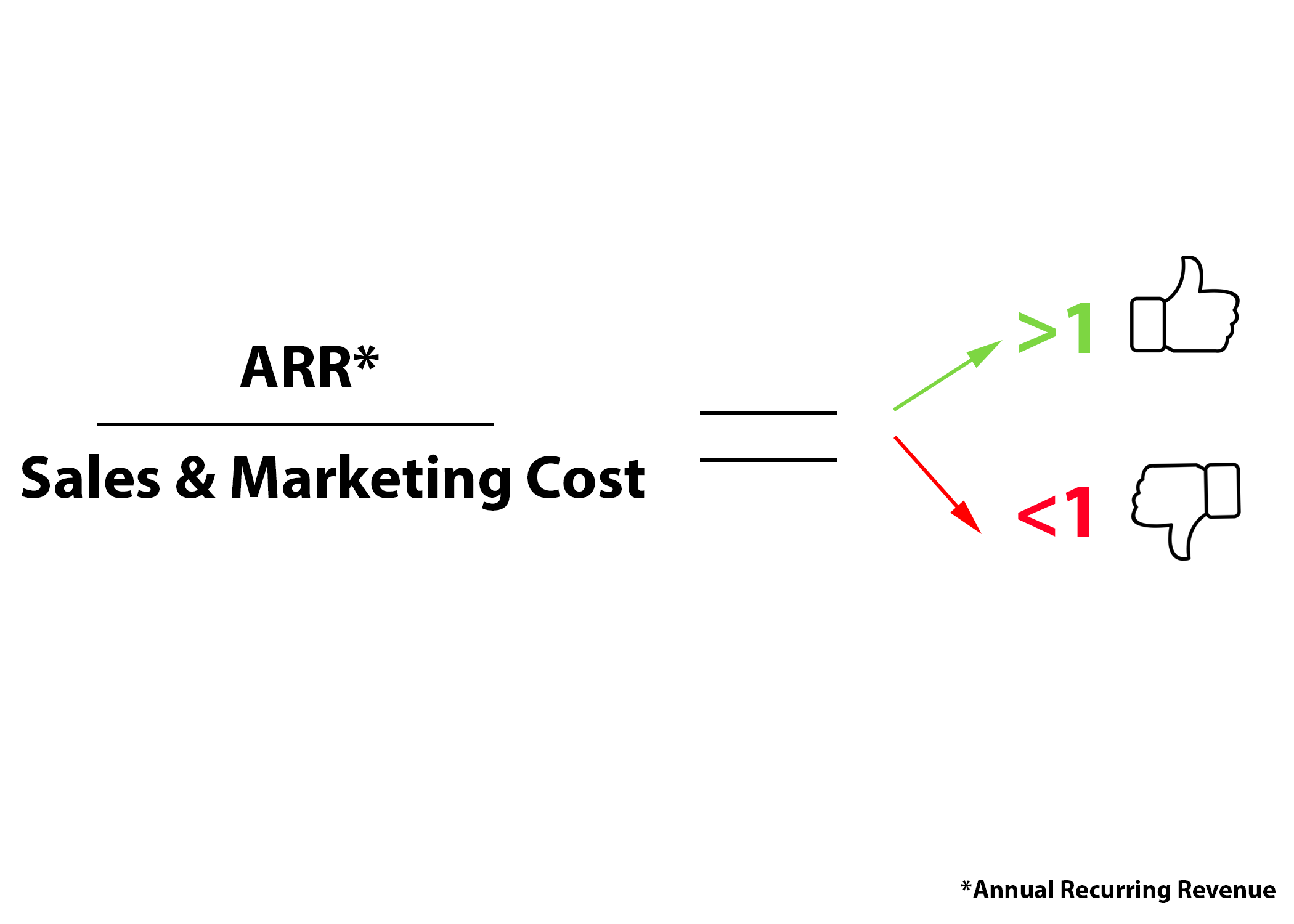How and why sales efficiency could help tech startups unlock growth
Sales efficiency is the best way to understand the economics of a business. To me, it answers the question as to whether a business can ever scale. The harsh truth is, if it can’t scale, investors won’t be interested.
Sales efficiency is more simple to measure than other related concepts like CAC (customer acquisition cost) or LTV (lifetime value). Here’s why:
· CAC is harder to truly measure, especially new CAC. In a SaaS organization, sometimes it can be hard to allocate those costs to what that new CAC is, as opposed to upsell or cross-sell within the same organization. Salespeople are almost always trying to pursue two goals:
· Trying to acquire new customers
· Selling within an existing customer (more seats within an established department, or expanding to a new division)
These activities generate different CAC; trying to strip out only the new CAC can be tricky. Sales efficiency, on the other hand, looks at all net new ARR (annual recurring revenue), which includes new customer ARR as well as expansion ARR.
· LTV tries to measure the value of a customer over time, assuming both repeat purchases and eventual churn; this gives you a good sense of the ultimate value of that customer to your business over time. The challenge with LTV in SaaS is that the data points that you might use to assume churn and repeat purchase behavior aren’t very robust — there are few SaaS businesses that have enough customers to really make these numbers reliable.
Enterprise businesses should focus on unit economics of sales early. When a business scales, it rarely buys you better economics — usually it just means more losses.

The role of sales efficiency in your ‘go-to-market fit’
At Storm Ventures we use a concept we call finding ‘go-to-market fit’ (GTM fit).
It is critical to the ultimate health of your business. Briefly summarized, GTM fit describes the stage in a business when the founder has found a product that has some resonance with a handful of customers — maybe the CEO is still the one at the company who’s selling everything — and they now have to figure out how to scale, which means the GTM motion needs to become something repeatable.
So how do you figure out the GTM motion that’ll work? Part of the answer is sales efficiency; figuring it out early may mean the difference between success and failure. Your exec team may decide to forgo profitability to grow — generally a great decision — but that doesn’t mean you can afford to ignore the sales model, unless you have literally unlimited capital.
Calculating sales efficiency
Generally speaking for a SaaS business, if you can spend $1 to generate $1 of new ARR, you’re on your way. Ideally, your ratio should be 1 or greater.
There are, of course, some nuances:
· You can shift your sales and marketing expense by one quarter if you find your sales cycle is longer than 90 days.
· If your margins are lower than a typical SaaS business, you need to have an even more efficient model, because profitability is even harder to find.
A good generic example might be hardware-enabled SaaS — a business that requires some hardware along with the SaaS (sensors, robotics), but whose value is in the software, which you sell as a subscription. In this case, margins are lower because of the cost of producing the hardware, so efficiencies in sales need to be higher.
I like to point to semiconductors as an example of how the low margin side can be worked with: semiconductors have lower gross margins but a readymade market. Intel’s margins, for example, are in the high 50-low 60% range. Compare that to Salesforce’smargins, which are 70%+. It’s all a question of where you spend your dollars.
Assessing your sales efficiency
If your sales efficiency is greater than 1, congratulations: you’re doing great. Caveat: just about everyone’s sales efficiency is >1 early on, because you have almost no costs. You’ll find that number sinking very quickly as the best salespeople (typically the founders) no longer scale and you need to add more; at that point, almost everyone goes below 1.
You just need to figure out a model that works, albeit at a small scale — then you can start to add more people and costs. Do this incrementally until you’ve got confidence in your GTM model.
If you’ve been in business for a while and your sales efficiency is still better than 1, you’re doing well. You’ve got room to play around: invest, double down, run some experiments; you could likely grow much quicker. For instance:
· Are outbound sales working? Hire another two reps and think about how to ramp them up as quickly as possible.
· Is your onboarding in general as streamlined as you’d like? Do you have a good process to follow? Sit down with whoever’s in charge of onboarding and see what you can tweak.
· Do you have your sales funnel instrumented and are you disciplined about it? If not, find a marketing ops specialist to consult.
· Are you doing anything for inbound? Start putting together content that will help your customers discover you.
One warning: content that’s just a big ad is a waste of time; you need to put together content that gives your customers actual value. Did they walk away knowing more about what you do? What problem do you solve? What makes your solution different? The more people out there who understand your business, the more potential customers might turn to you looking for a solution.
How to improve your score
What happens if your sales efficiency is way under 1? If you’re spending significantly more than a dollar, we need to step back and figure out what’s wrong. Let’s start with your business model; focus on figuring out which costs are out of line:
· Where is there friction?
· Are your leads converting?
· What are your sales costs?
· What are your marketing costs?
· What are your customer success costs?
Spend time here before investing more; it’ll help focus you on a path to success.
One common pitfall I’ve seen has to do with sales, specifically sales rep productivity and quota. Let’s say you’re paying your reps $150K OTE (on target earnings including commission) and their annual quota is $500K. Seems good on paper, right? In practice, not so much: you’re going to have serious trouble scaling this model, because it turns out you’re spending much more on your reps than you thought. Typically, sales reps have some support, such as:
· A sales development rep who generates leads and sets up meetings (usual cost: $80–90K)
· A department VP/supervisor
· A sales engineer who needs to be involved in onboarding customers
Now add in marketing costs and any overhead you may have also forgotten, and you can quickly see it’s challenging. In fact, you’re likely not even returning your sales spend on the contract value. Most quotas need to be 4xOTE and then some to make a model work. Either you’ve set your quota incorrectly, or your sales model just doesn’t scale.
Some more examples
Let’s look at a bad example first:
Company X offered a fairly complex product, and had settled on a land-and-expand sales strategy:
1. Get a low-friction, easy win with a customer by not charging a lot
2. Prove out value
3. Sell more once the customer realizes the value of the product
It was a good idea in theory, but Company X’s sales efficiency took a triple hit:
· Because the product was extremely complex and required a lot of domain expertise, Company X’s sales people were very highly compensated.
· Company X landed a lot of small accounts. Unfortunately, the product had a super complex install, so it required a lot of resources to set up. This raised the cost of selling significantly. (Side note: in my opinion, the end goal of selling in a SaaS business is not to collect revenue on that initial sale — the ultimate goal is to make an incredibly happy customer. When you do that, the revenue flows, but so do expansion and referrals. Ask yourself: “How do I create time-to-value quickly and make a happy customer?”)
· A bunch of customers were unhappy because Company X failed to get the product implemented well. Since they sold it at a low price point, they ultimately saw a lot of churn.
The core problem Company X had was a failure to appreciate the technical complexity of their product. This happens a lot: founders know the domain better than anyone, so it’s sometimes easy for them to assume their customers have that same capability and experience. Most of the time, that’s not true, and even if they do have the technical expertise, they don’t want to spend a lot of time trying to configure something they paid for!
Now a good example:
Company Y had a SaaS product that delivered insights to their customers that were based on gathering vast amounts of data that exist on the Web. Initially, the company was collecting the data, generating insights, and packaging them in a digestible way; they didn’t want to make the customer do a lot of work. This process used to require a human, which came with associated costs.
Their solution: automating the distillation and insight packaging process, reducing those costs. This had two benefits:
· Insights to customers were delivered in a more cost-effective, reliable, consistent way.
· Company Y dropped the cost of the application, which opened up whole new customer segments that previously couldn’t afford to pay what was required to justify the price before.
Other tools
Sales efficiency is just a metric, and in my experience, you need to look at metrics in the context of your business. In other words, sales efficiency is a tool rather than a shortcut. Other tools include:
· Developing sales funnel metrics
· Setting quota and commissions
· Onboarding
· Churn
Entrepreneurs need to understand their whole business and not get lost in a spreadsheet; everything needs to have context. And above all else, be honest with yourself about where the business is: otherwise you’re just setting your own fire.
Originally published on TechCrunch (behind the paywall)
